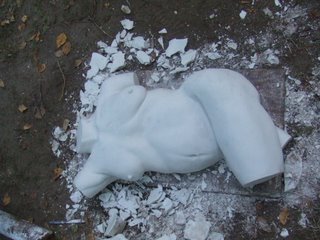(September 2005)
So after a clay sculpture is completed it must have a mold cast from it in order to make it in some way permanent. Unlike the Tile where it was made from a firing clay, most of the sculpture work I do is done in clay that is much like what you dig out of the ground. In the sculpture case it comes from a special mine in Kentucky, I think. But that just because it's a consistent quality.
Making the mold, then casting it is a involved process, and not a very artistic process. I'm going to try not to get into too much detail. In the end it's not all that exciting.
In this case the sculpture allowed for a one piece mold. This is the simplest case, and as the name suggest the mold only has one piece. The more complicated the shape, the more pieces you need for the mold.
The mold is made from simple plaster. It is layered on for strength, and finally a layer of burlap is applied to hold it all together. Once the mold is completed the final material is poured inside the mold and allowed to harden. In this case the mold is a waste mold, because the mold is destroyed in order to remove the sculpture from it.
In the picture above the piece has already been cast. Because this mold is so big it would be impossibly heavy to cast it solid. So instead I cast it as a shell. This sculpture is case in Densite, which is a plaster like material but it cures harder. To cast the shell I poured some Densite into the mold, then tipped the mold and allowed the densite to cover all the surfaces. I did this repeatedly until the entire inner surface of the mold was covered to a thickness between .5 and 1 cm thick. Over that I placed a layer of Fiberglas soaked in Densite, and for good measure I added a grid work of wire to hold everything together.
Getting the piece out of the mold is a matter of breaking the mold off the piece. This is done with a wooden hammer and chisel. In this case I was at the cottage and didn't have a wooden hammer, so instead I used a log. The wooden hammer is desirable over metal or rubber because of its rebound properties. It gives a much better feel for what is happening at the chisel blade. Metal hammers give to sharp a strike and rubber is too bouncy.
This mold came off quite easily. Because the sculpture was so smooth in many places large chunks of the mold just fall away after being struck.
This is also a very satisfying part of the process because you get to see the sculpture again for the first time in a long time. In this case about 6 months.
Finishing this piece involves sanding off the mold sheen and other imperfections. I didn't get to that till this summer.
Wednesday, July 19, 2006
Subscribe to:
Posts (Atom)



